by Christopher Hector and Gemma Alexander
Being an equestrian journalist was never really what you call mainstream, but an equestrian journalist with a major interest in sporthorse breeding? Then you are starting to disappear off most peoples’ radar. It’s great then to occasionally hook up with a new young face who shares the passion. Intriguing to receive an email at the end of last year from Western Australia from a Gemma Alexander, expressing interest in the work I had done in the area and suggesting that we might get together on a project at some stage in the future.

Gemma runs a smart website, pacificjumpingbreeding.com, offering her services and knowledge to breeders. I thought it might be an idea to take her up on the offer and together we might investigate something that had been floating around in my head ever since I interviewed Dutch breeding expert, Arie Harmon at the 2017 World Young Dressage Horse Championships. I asked him if the KWPN would be following the lead of the German FN, and separating the breeding values into two tables: one based on results in young horse competition, and one on the results of open competition. He suggested that this wasn’t necessary, and that one could gain this sort of information by tracking the fortunes of stallions over a period of time. Thus, looking at Jazz, we could see that he started with an okay value, but that this greatly improved over time as his progeny starred in the higher levels of the sport. Similarly we could identify the young horse shooting stars as their values plummeted.
The German FN were only too happy to make available the values for 2002 and 2012, which joined to the 2017 values they had already sent, provided food for thought. The Dutch, who inspired the project, were not so happy, saying that the changes in the way the values were calculated made comparisons invalid, and would not listen to my argument that we were not about to compare different stallions from different eras, but look at how an individual stallion’s fortunes fluctuated over time and how accurate this might be as a estimation of his worth as a sire. Of course ‘the numbers’ themselves, have no absolute worth and will vary with the ways they are calculated, but that is not what we are looking at. The breeding values were always supposed to be a guide to breeders, so if a stallion is in the top ten, this is a suggestion to use that stallion. If the stallion stays in the top ten over a period of time, then the evaluation gains strength. If however, we have stallions that regularly feature with very high breeding values (ie. compared to other stallions of that year) but they then appear a while later, with very low values (compared to stallions of that year), especially when the reliability index remains more or less constant, then we call into question the values themselves as a guide to the breeder…
However, I do have a copy of the 2011/12 KWPN values and when the new ones emerge in a couple of weeks, can follow Arie’s advice.
Next Gemma talks about ‘the numbers’.
Meantime, it was Gemma’s turn to taste the wonder of ‘the numbers’ and I shot the German lists over the continent to her. Her reaction?
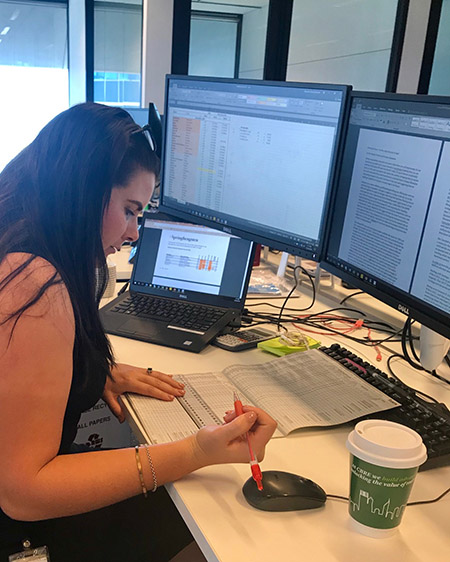
I’m someone who has made a career out of analyzing statistics, so when Chris suggested I get stuck into the German FN rankings – something I have not previously considered much as a breeder – I was quite interested to learn how this revered breeding-by-numbers system worked.
From the data provided by the German FN (2017 stallions with rankings greater than 128; 2012 and 2002 stallions with rankings greater than 140), the first thing that struck me as odd was that only four stallions had earnt a ranking place in all three subject years: Carthago (Capitol I / Calando I), Concerto II (Contender / Ahorn Z), Stakkato (Spartan / Pygmalion) and Cassini I (Capitol I / Caletto II). The top 24(!!) horses in 2017 did not record a ranking in all three years. My initial thought was that this must be due to the fact that these stallions were obviously younger, with progeny not of an age in 2002 and 2012 to boost their rankings… But then I realized the top five were: Heartbreaker (Nimmerdor / Silvano, born 1989), Diamant de Sémilly (Le Tot de Sémilly / Elf III, born 1991), Kannan (Voltaire / Nimmerdor, born 1992), Galoubet A (Almé / Nystag, born 1972) and Quick Star (Galoubet A / Nithard X, born 1982). These are heavyweights in the stallion world with internationally starring progeny dating back decades… yet none of these stallions had rankings greater than 140 in either (or both!) 2002 and 2012? The first alarm bells started ringing.
But I decided to look past this (after all I am no expert in the system, there must be a reason for these omissions, right?), and investigate Arie Harmon’s claim that you could quickly and easily identify the top producing stallions with ‘staying power’ – as opposed with those who just produce super young horse class horses – by tracking which stallions’ rankings go up over time (as was the case with Jazz, mentioned earlier).
In order to have the greatest level of accuracy, I decided to look only at the four stallions who had recorded a ranking in all three of the subject years.
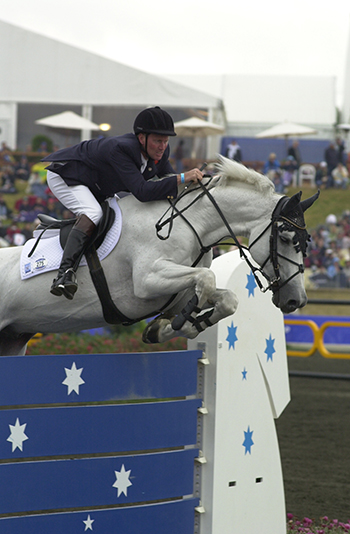
Carthago – up and DOWN on the German rankings…
Starting with Carthago: 156 in 2002 with 97% accuracy, improving to 158 with 97% in 2012; so far so good. Carthago is looking like he is a producer with longevity. Then 2017? Down to 149 with 98% accuracy. What? Ok so maybe Carthago isn’t the producer of top competitors that we thought, live and learn.
Moving on to Concerto II: 151 in 2002 with 91% accuracy, improving to 155 with 92% in 2012… and then down to 146 and 91% in 2017? Another producer of young horse class horses, who hasn’t consistently bred Grand Prix stars? And why did the accuracy go down? One could reasonably assume that the stallion had more progeny on the ground in 2017 than in 2012, and the greater the number of progeny the greater the reliability of the estimations, right? Now I’m starting to get skeptical.
Next, the great Stakkato: 169 in 2002 with 84% accuracy, up to 170 with 98% in 2012; looking promising. And then… 138 in 2017 with 98% accuracy?? How could the stallion be given a value of 170 in 2012 with 98% accuracy, and then five years later go crashing to a value of 138 (32 points!), but still with an accuracy of 98%? At this point, my brain very nearly explodes.
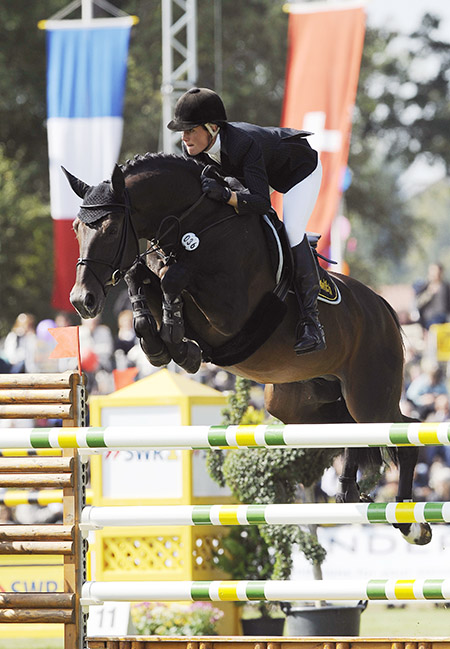
Stakkato crashes and Gemma’s brain is about to explode!
Surely Cassini I will prove the merit of these rankings: 154 in 2002 with 96% accuracy, unchanged in 2012 at 154 however with accuracy increased to 98%… and then plummeting to 132 in 2017, but still with 98% accuracy. It is at this point I actually laughed out loud.
ANYWAY.
next we compare the rankings
So how do the German FN rankings compare with the widely used WBFSH and Horsetelex rankings?
2017 Rankings
| German FN | WBFSH | Horsetelex | |
| 1 | Heartbreaker | Chacco-Blue | Chacco-Blue |
| 2 | Diamant de Sémilly | Diamant de Sémilly | Diamant de Sémilly |
| 3 | Kannan | For Pleasure | Cornet Obolensky |
| 4 | Galoubet A | Cornet Obolensky | For Pleasure |
| 5 | Quick Star | Casall | Kashmir van Schuttershof |
| 6 | Stakkato Gold | Kashmir van Schuttershof | Casall |
| 7 | Cardento | Kannan | Quidam de Revel |
| 8 | Carvallo BB | Baloubet du Rouet | Nabab de Rêve |
| 9 | Lupicor | Balou du Rouet | Thunder van de Zuuthoeve |
| 10 | Toulon | Berlin (Caspar) | Baloubet du Rouet |
The WBFSH and Horsetelex rankings are remarkably similar, with 7 stallions appearing in the top 10 of both rankings. However, the same can’t be said of the FN top 10: there is no Chacco-Blue, no For Pleasure, no Cornet Obolensky, no Kashmir van Schuttershof, no Casall, no Baloubet du Rouet… yet it includes the likes of Stakkato Gold (Stakkato / Werther)? Does any breeder seriously consider this (admittedly nice) stallion to be a better and more reliable producer than those just mentioned? I seriously doubt it. Stakkato Gold comes in at number 73 in the WBFSH rankings and number 108 in the Horsetelex rankings; and we find him at number six on the German FN rankings. Then I went in search of FN’s number eight rank, Carvallo BB (Carthago / Lavall II). He is not in the WBFSH top 100, and to find him in the Horsetelex rankings I had to search to page 123 where he is ranked 2452nd! Ranked above him are the AWHA stallions who have stood their whole careers in Australia: Belcam Gambler, Wirragulla Nicklaus and Woodleigh Don Juan. And according to the German FN rankings this is one of the top 10 best jumping sires in the world with a reliability of 85%.
I am not convinced. I am now quite confident in saying that as both a breeding analyst and a breeder, these rankings are of very little value.
I am looking forward to conducting a similar exercise with the KWPN rankings upon their release in the coming weeks. Who knows what kind of story they will tell?
Well Chris, thanks for the laughs.
The German Dressage Values
Christopher Hector takes up the story:
I decided that having dropped Gemma into the murky world of jumping breeding values, it would be outright cruelty to subject her to the vaguaries, not to mention outright insanity, of the dressage listings, there are some responsibilities that come with age…
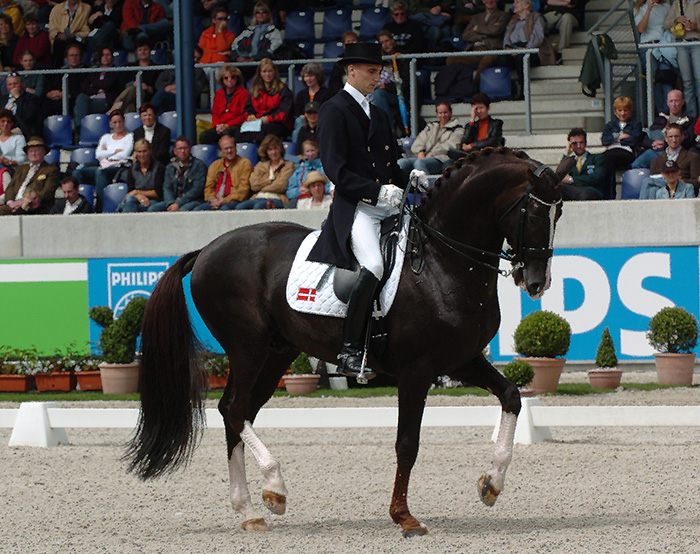
Don Schufro – there for the long haul…
The most striking thing about the 2002 German FN list is just how many really fine stallions there were in the line-up. Gone were the days when dressage horses were jumpers who couldn’t jump. The top stallion of 2002 with a value of 174 was Don Schufro (Donnerhall / Pik Bube I) who is still a major force fourteen years later, not to mention sire of the current world’s number one dressage competitor.
Of the top ten (really fourteen but there are four on 155) there is scarcely a dud to be found. In second to Don Schufro we find Wolkentanz I (Weltmeyer / Ludendorff) and Fidermark (Florestan / Werther). In fourth on 160, the first of the oh my how did that get there? – the Bavarian stallion Rivero II by Rautenstein – a Ramiro grand son, out of a Furioso II mare – out of an Argentan II mare. Studying the list of Rivero’s progeny it’s no surprise we’ve forgotten him.
Welt Hit I0 (Weltmeyer / Hill Hawk xx) is next on 158, a decent stallion although time was to show that his younger brother, Welt Hit II was to prove the more successful sire – perhaps because he stood in Holland where there was less competition for mares for a dressage stallion. On these rankings, Welt Hit II scored 140, finishing in = 59th, equal indeed with Rubinstein (Rosenkavalier / Angelo xx).
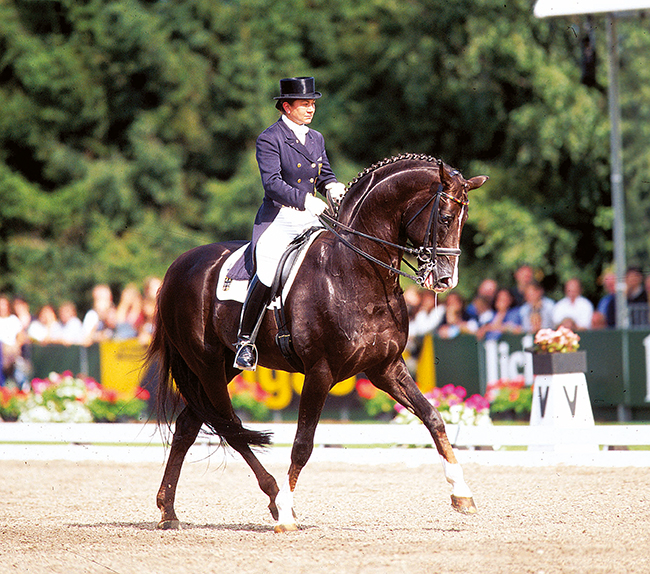
Donnerhall – Dominator
In equal sixth on 157, we have Donnerhall (Donnerwetter / Markus) and his son, Don Primero (Pik Bube I), while Wolkentanz II and Royal Diamond (Rubinstein / Inschallah) are equal eighth on 156. In the battle of the sibs, Royal Diamond failed to produce anything of note, while his full-brother, Rohdiamant is arguably the best son of Rubinstein and he was = 16 on this table with 153. There is quite a classy group tied in equal tenth on 155: De Niro (Donnerhall / Akzent II), Weltmeyer (World Cup I / Absatz), White Magic (Weltmeyer / Bolero) and D’Olympic (Donnerhall / Cor de la Bryère).
Already that D line is establishing a dominance that will continue up to today, there’s Donnerhall himself and three of his sons in the top ten.
Moving on to 2012, and the flow of dressage blood across the border has begun, Jazz (Cocktail / Ulster) has joined Don Schufro at the top of the table, on 170. In third we have a stallion that was briefly touted as Hanover’s next new dressage sire star, Londontime (Londonderry out of a Walt Disney mare). Alas, he, like his sire, failed to live up to the hype. Londontime’s personal international competition record consisted of a 29th in the 6 year old class at the World Young Dressage Horse Champs, and the twelve progeny that have made it onto the hippomundo database have not done anything interesting.
Fourth on 167 to Damon Hill (Donnerhall / Rubinstein ). He was a genuine star as a competitor, and is an intriguing prospect as a sire, although we are still waiting for a Grand Prix star from him and perhaps he is a young horse specialist.
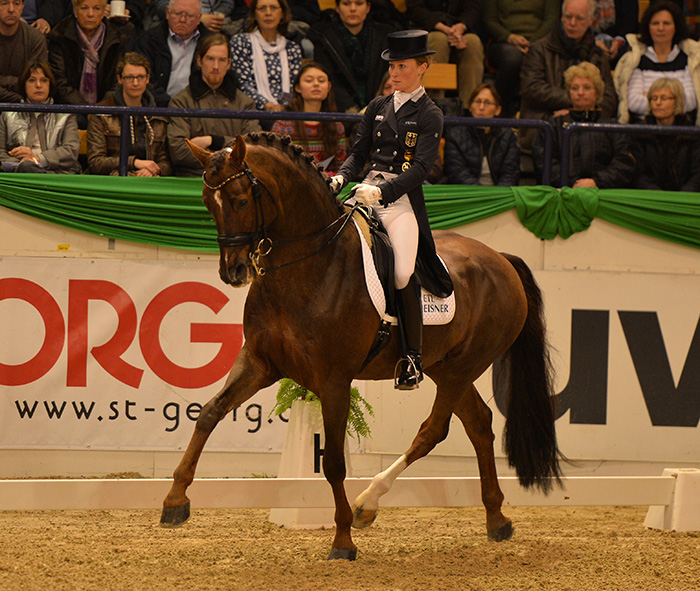
Damon Hill – young horse sire or big sport sire?
Fifth to Burlington (Breitling / Rohdiamant) on 165, while his sire, Breitling (Bismark / Maat) is sixth on 166. Breitling is to come into his own on the new values that separate young horse results from open competition.
Seventh on 163 to a pair of shooting stars, Real Diamond (Rohdiamant / Weltmeyer) and Rock Forever (Rockwell / Landstreicher), and in equal ninth, a forgettable duo of Dancing Dynamit (Don Bedo / Fidermark), and – this time they really got the wrong brother – Welt Hit IV (Weltmeyer / Hill Hawk xx).
Interesting the relative absence of the S line. On our 2002 list, Sandro Hit languished in = 36th, on this 2012 ranking, his sons are somewhat down the line: Sir Donnerhall (Donnerhall) 160, Sancisco (Rohdiamant) and Sarkozy (Weltmeyer) on 155, Scolari (De Niro) on 153, and Samba Hit II (Brentano II) on 152.
Faced with the reality that the breeding values were favoring young stallion sires of young dressage horse competitors, the FN decided in 2016 to split the values into two tables, one that measures success as a young horse sire, the other that looks at competitors in open competition. This did produce two very different lists. This year’s young horse list is mainly speculative, headed by a horse that has done nothing and bred nothing, Follow Me (Fürstenball / Donnerschwee), tied with Escolar (Estobar / Fürst Piccolo) who was second the Nürnberger Burg-Pokal last year, though even the rider of the winning horse, Isabell Werth, thought him the winner. It is interesting that the fabled Westfalien E line had almost disappeared fifteen years ago. There was not one single E on the 2002 list. Estobar (Ehrentusch / Ferragamo), who seems to have single handedly saved the letter from oblivion, appears on the 2012 list with a value of 156, in 18th place, five years later, his value is 145, once again in 18th.
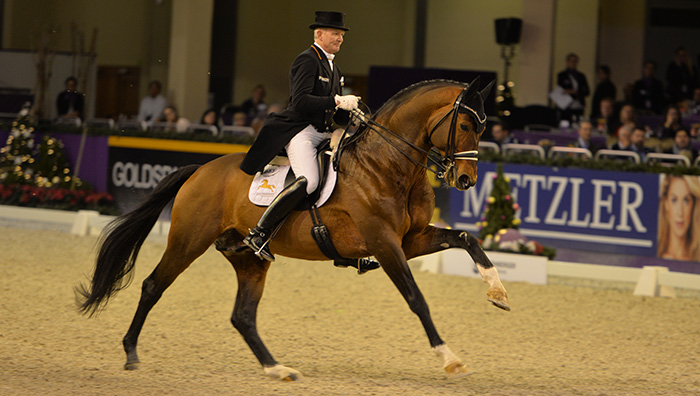
Escolar – the E line lives!
The Dutch are still something of a force with two Dutchmen tied on 168: Vivaldi (Krack C / Jazz) and Don Juan de Hus (Jazz / Krack C). Damon Hill is the 7th highest ranked young horse sire, with Lissaro (Lissabon / Matcho aa), who was Number 1 on the 2015 rankings, squeezing into the new top ten despite having produced nothing of note.
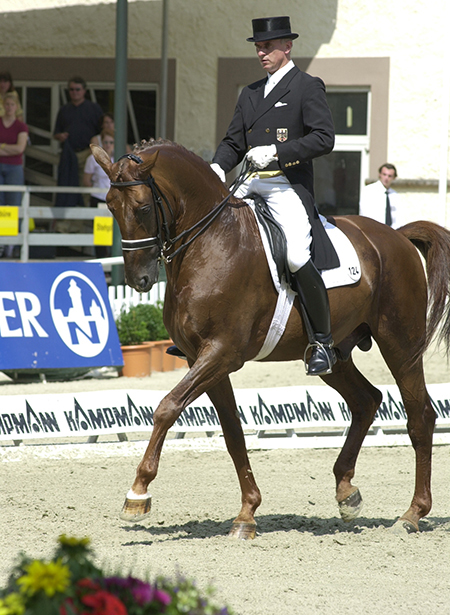
Breitling – a real sire of Grand Prix horses
The open competition standings show the benefit of getting rid of the randomizing young horse distraction. Breitling is a great number one, even if he died in 2015 without covering a fraction of the mares he deserved. Then Don Schufro and Jazz tied in second, Damon Hill is fourth on 160, then we start to get loopy again with Lissaro in fifth on 159. Dressage Royal (Donnerhall / Rubinstein) is on equal 7th with Vitalis (Vivaldi / D-Day) on 151. To round out the top ten on 149: Donnerhall (Donnerwetter / Markus, 99%), Florencio (Florestan / Weltmeyer, 96%), Lord Loxley I (Lord Sinclair / Weltmeyer, 94%) and Welt Hit II (Weltmeyer / Hill Hawk xx, 92%) with his full-brother, Welt Hit 1O on 148 (79%) – these two are the last remnants of the once mighty Weltmeyer machine…
So who was there fifteen years ago where we started this comparison that has lasted to 2017? Not many: just Don Schufro, Fidermark, Welt Hit I and II, Donnerhall, Florestan and Rohdiamant.
It is hard to come to terms with De Niro not making the top ten, let alone the top fifty in 2017 – he was 10th in 2002 and you would have thought he just went from strength to strength in the past 15 years – dominating the sport at a championship level like no other sire. The system is still not perfect…
The Germans are very coy about revealing OCD figures, but looking at the new Dutch values, we can shed a little light on the top German stallions. De Niro is once again a star, with a positive 106, while Damon Hill scores 101. Vitalis (Vivaldi / D-Day) who is wildly popular in some circles comes in at 100, while if you mortgaged the house to breed to Totilas (Gribaldi / Glendale) you might not be so happy to learn that he scores a negative 97.
we look at the KWPN values next
Would you like to breed to Breitling? Or another top European stallion? You can, go to www.ihb.com.au and see the selection of beautiful stallions that are available in Australia: www.ihb.com.au
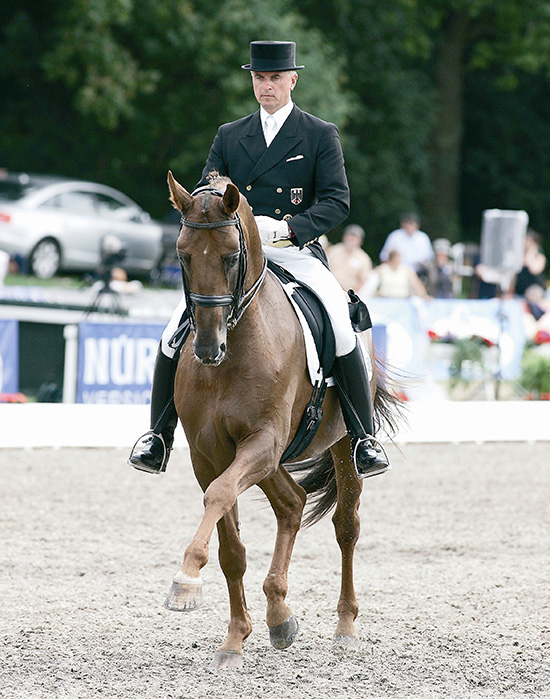
Now let’s see what our Dutch pals come up with…
Christopher Hector looks at the KWPN Dressage Values 2018
Weltmeyer may have fallen from his perch in Germany, but in Holland, Jazz just keeps swinging along. As I write this piece, news comes through from the Dutch Indoor champs, that the Juniors have been won by the 17-year-old Jazz son, Victory, while the Small Tour champion was Adelinde Cornelissen’s full brother to Parzival, Fleau de Baian (Jazz / Ulft), with Adelinde second in the Grand Prix with another Jazz, Zephyr (out of a Farmer mare). And there he is, up top again for 2017/18 with a dressage value of 190.
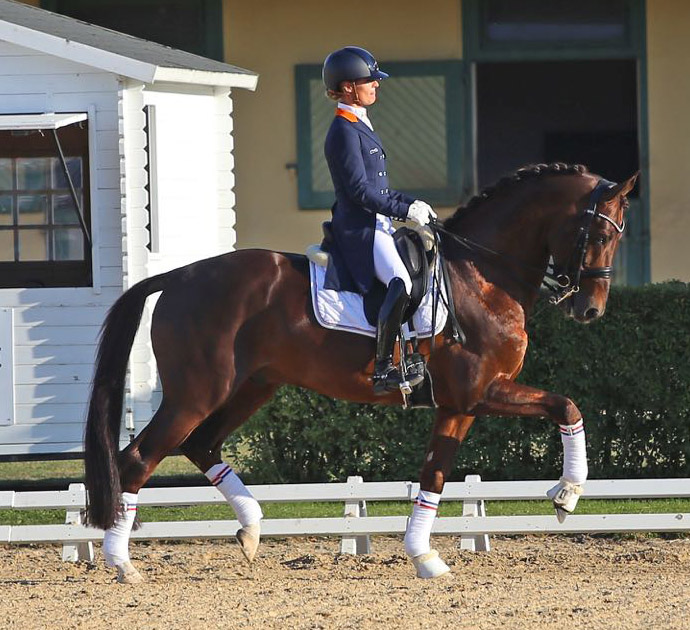
Adelinde wins with Parzival’s younger brother, Fleau de Baian
There have been a number of changes to the values this year. While the stallions are grouped according to their reliability, with Jazz heading the cohort with a reliability of +90%, the individual scores for reliability seem to have disappeared. Previous years provided the invaluable statistics – the number of competitors over 4 years old and the number of progeny over 4, which meant you could accurately calculate the percentage of progeny that made it to the competition ring, sometimes to the embarrassment of the top stallions. It has not been a good year for those of us who try to glean useful information out of the numbers. Earlier this year the WBFSH sire standings appeared, but without the very useful table that appeared in the past showing the top 50 with their progeny. Now the participation figures seem to have disappeared**** and instead we have a new measurement: Verwantschaps percentage met dressuur populatie, which I am informed by the ever helpful Charlotte Dekker in the KWPN press office means:
Verwantschap means kinship and has to do with inbreeding management. In the dressage population we see a high inbreeding increase over 1 generation at the moment, not very bad, but attention should be paid, so management in this topic is necessary. One of the things is to provide the kinship of the dressage stallions with the total dressage population. This number tells you how unique the pedigree of the stallion is in its population. The lower the % the better, when a low% stallion will be used this helps to decrease the inbreeding in the population. Breeders have access to a special inbreeding tool to see the specific figures for their mares in combination with the available stallions.
Not surprisingly, Jazz has the highest inbreeding % – 5.1, and if Vivaldi is the next big thing, he is not much better, 4.7 – which is the second highest level. Of the stallions that are still alive, the ones with German breeding, not surprisingly, come up better: Wynton who is out of a mare by Kyra Kyrklund’s Danish bred star, Matador out of an Oldenburg mare by Rubinstein, is on 2.9, while Painted Black, by the German Trakehner, Gribaldi, scores 2.4.
**** I am now told that the participation rates will be calculated and made available at some unspecified time in the future, meantime I have asked for the rates for the top ten stallions over 90% plus the numbers for the stallion with the highest participation rate if he is not in the top ten +90. Watch this space
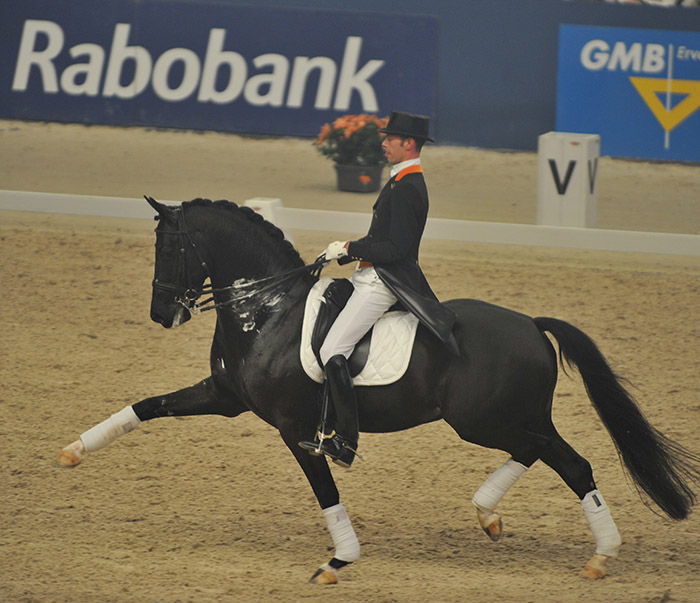
Looking for an out-cross? Try Painted Black…
Jazz’s dominance of Dutch dressage breeding is underlined when we find three of his sons in the top ten: Olivi (Aktion) is second, Johnson (Flemmingh) fifth and Wynton (Matador), sixth. I guess it is a bit of a worry that the only two OCD scores revealed for the top ten are for Jazz and Wynton and they both have a negative 97 (100 is neutral, anything greater than that positive).
I suspect that Gribaldi’s final performance at the KWPN stallion show in 2010 will linger in the memories of all that saw it, sadly the 17-year-old stallion was dead a week later, but the Gribaldi (Kostolany / Ibikus) influence lingers: his son, Painted Black (Ferro) is third, while he himself holds down 7th spot.
Then and now…
Looking back to the 2011/12 values not much has changed. Back then Jazz was on top with a score of 194. This time the major ranking was for stallions with the oldest offspring aged at least ten.
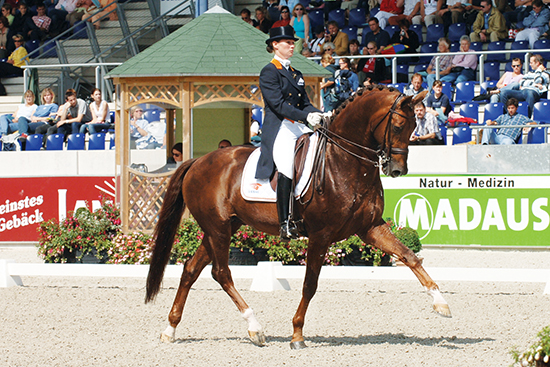
Jazz – number one again
Contango (Contender / Kronprnz) was second. Contango’s ranking is truly amazing given that he only stood two seasons in Holland for 500 foals before he was exported to the States in 1995 – and because he was EVA positive, his semen could not be sent back.
Johan Hamminga rode the German born stallion in his Dutch performance test:
“Contango was a little bit before his time in Holland – now we have more ‘blood’ in the mares and you see a lot of children of Contango in Holland. Everyone wants to Contango in the dam line because they have very high rideability, they can collect very easily, and they have a lot of potential for Grand Prix, and that’s what we like from Contango. Now everyone says Contango, Contango, but we had him 20 years ago…”
Olivi was third then on 175 and is now second on 183, which is not surprising as several of his progeny are now featuring in the Big Sport. Painted Black was showing promise, third in the rankings for stallions with offspring 7 – 9.
It is in the 2011/12 rankings of stallions with progeny aged 4 – 6 that we find some of the horses that have made the move into the top ranks – we also see some that have fallen by the wayside.
In first place was Citango (Contango / Jazz) who back then had a breeding value of 182, these days his value has plummeted to 140 and he languishes in 23rd spot on the values for stallions with a reliability of less than 80%.
In second place was Westpoint (Jazz / Michelangelo) with a breeding value of 182. On the 2017/18 values Westpoint is second in the group of stallions with a reliability of 80 – 89% on a score of 154 behind Sir Sinclair (Lord Sinclair / Flemmingh) whose career seems to have stalled. Sir Sinclair was 12th in the 7 – 9 age group in 2011/12.
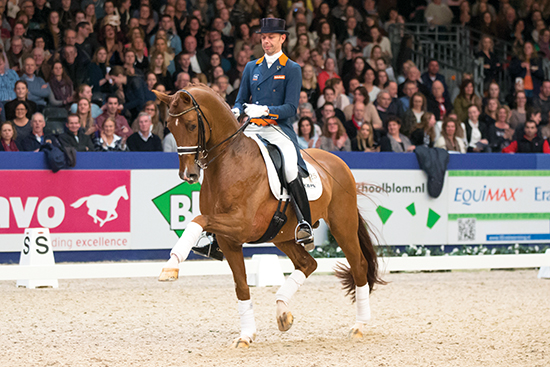
Vivaldi – next big thing?
Third to a stallion that just might be one of the good ones – Vivaldi who has leapt up into the leading group. Back in 2011/12, his value was 167, now it is 168, so it is not so much that his value has increased but that the horses in front of him have had their breeding values reduced. This is precisely what Arie was suggesting we should be looking for, and indeed, in that interview, he singled out Vivaldi as one to watch.
Another from the 4 – 6 group to last the distance is Johnson (Jazz / Flemmingh) who has impressed, not only with his personal performances but also with the quality of his get. In 2011/12 he had a breeding value of 146, and was 12th. On the latest standings his value is 157 and he is in 5th place in the over 90% group.
The group of stallions with offspring competing in studbook inspections but not in dressage competition, was headed by Wynton (Jazz / Matador) who is another to make a great leap forwards. He is now in =fifth in the 0ver 90% group in the latest standings with a value of 157.
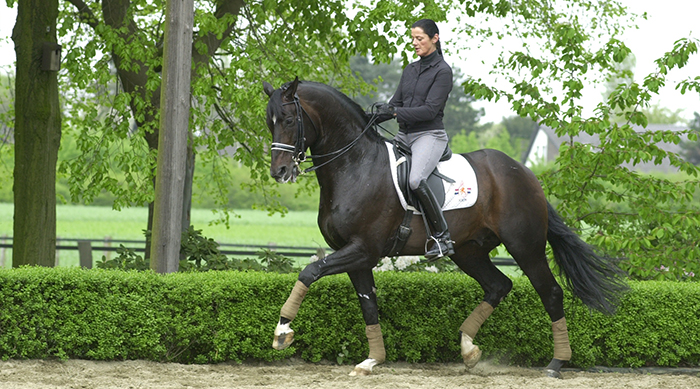
Welt Hit II – what a star!
There is one stallion who deserves to be honoured, and that is Welt Hit II. He was one of the few stallions to appear on the 2002 German standings, and still be there in the top ten on the 2018 values. On the KWPN values in 2011/12, Welt Hit II was 14th on the list of stallions with progeny at least 10 years old, with a breeding value of 148. Six years later, he is 15th on the list of stallions with a reliability of over 90%, with a breeding value of 147.
Welt Hit II also had a remarkable ratio of foals to competitors. On the 2015/16 KWPN dressage values, he was credited with 653 progeny over the age of 4 – 284 competitors for a ratio of 43.491 which was far-and-away the highest. Jazz at the head of the table that year had a ratio of 35.268. One hopes the KWPN will see the error of their ways and include those stats in next year’s values…
next the jumping sires
Over to you Gemma to see what the jumping stallions have done…
Gemma Alexander looks at the KWPN Jumping Values 2018
The very first thing to strike me when looking at the rankings provided by the KWPN (2018, 2015 and 2011/12) is that there already appears to be a far greater degree of consistency than what was found in the German FN rankings; of the top 50 ranked horses in 2018 (with accuracy greater than 90%), 42 of them also recorded a ranking in 2015 and 2011/12, as opposed to the German rankings where only four horses IN TOTAL had made the rankings in all three subject years. So I am already feeling optimistic.
While the major ranking in 2018 and 2015 were for stallions with a reliability of over 90%, 2011/12 differed slightly in that the main ranking was for stallions with oldest offspring at least 10 years of age. As the 2011/12 data included individual reliability figures, for the sake of consistency I have viewed all years with the top rankings over 90% reliability.
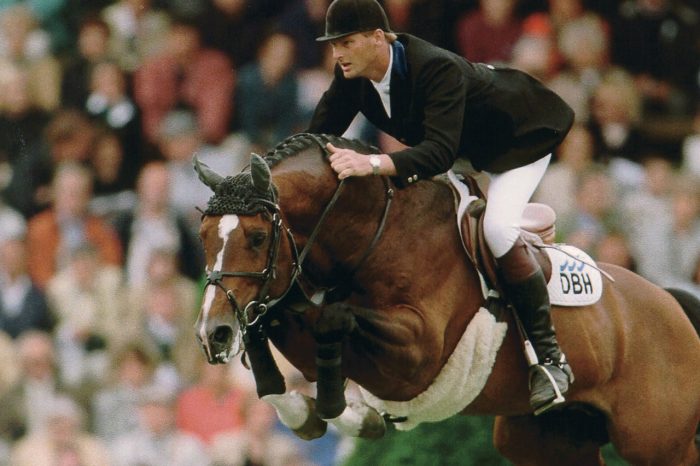
Heartbreaker – what a stallion!
The rankings leader in 2018 is the timeless Heartbreaker (Nimmerdor / Silvano) with 171 points; Heartbreaker also topped the rankings in 2015 (breeding value 182) and 2011/12 (value 175). A worthy rankings leader; there are not many international 1.60m Grand Prix’s without a Heartbreaker in the start list.
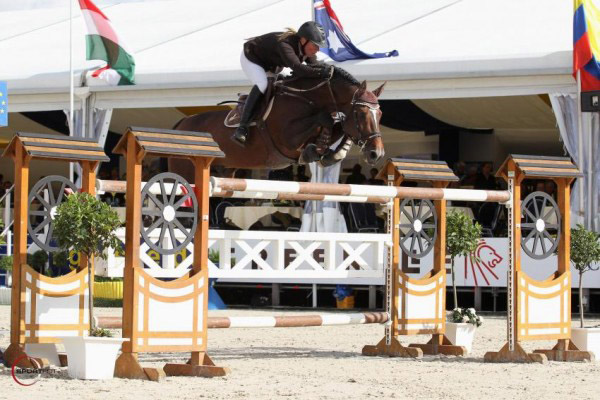
Harley – a surprise?
Second place in the 2018 rankings is somewhat of a surprise, the Heartbreaker son Harley VDL (damsire Carthago); his best-performed offspring is Charly Chaplin S (Harley VDL / Burggraaf) who comes in on the Horsetelex Jumping Horse Rankings at 142nd, who picked up a win in the 2017 LGCT Shanghai and a 3rd in the 2017 LGCT Cannes 5* Grand Prix’s under the saddle of Darragh Kenny (IRL). In 2015 Harley VDL did not make the main ranking list, with a value of 147 and a reliability of 86% keeping him in the second-tier rankings. This stallion does appear to be an up-and-coming powerhouse in the breeding world, also making his debut in the WBFSH Top 100 Jumping Sires in 2017 in an impressive 61st position.

Berlin – consistent
Third place in the 2018 rankings goes to Berlin – formerly Caspar – (Cassini I / Caretino) with a breeding value of 159. Berlin was also in the 90%-plus bracket in 2015 (with a value of 149) and was only marginally outside it in 2011/12 at 87%, with a ranking value of 147. It would seem that Berlin is quite the consistent producer of international jumpers, despite only having two competitors in the Horsetelex Top 100: Bull Run’s Faustino de Tili (Berlin / Darco) at 24th and Berlinda (Berlin / Gento) at 85th. Berlin also comes in at number 10 on the current WBFSH Top 100 Jumping Sires list, so it would appear that the Dutch don’t play as far outside the box (at least as far as I have read!) as the Germans do.
Fourth place goes to another son of Heartbreaker, Padinus (damsire Grannus) with a value of 154; in the 2015 rankings he was placed second with 161 with 92% reliability, and in 2011/12 he scored 152 with a reliability of 89%. While his value has dropped somewhat, his position in the rankings indicate his prepotency and reliability as a jumping sire. Another deserving ranking.
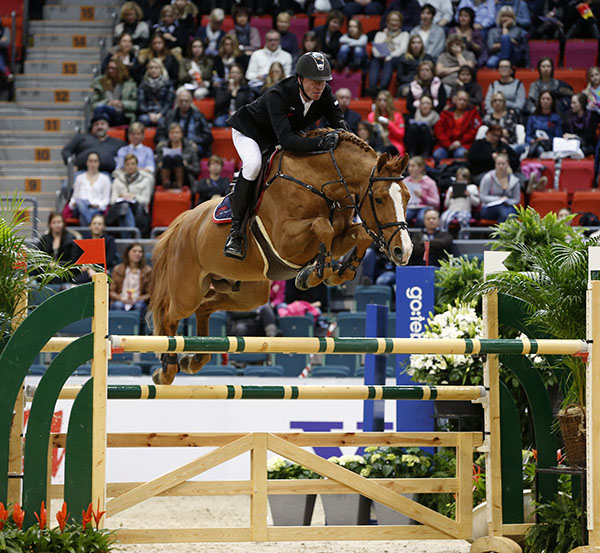
The wildcard – Arezzo VDL
Fifth place goes to probably the biggest wildcard, Arezzo VDL (Chin Chin / Heartbreaker) with a value of 154. This stallion did not record a ranking value in 2011/12, and in 2015 he scored a value of 162 with a significantly lower reliability of 83%. The top-earning offspring in the Horsetelex rankings is VDL Edgar M (Arezzo VDL / Marlon) who comes in at 596th, with his best results being wins in 3* classes in Herning and Warsaw. Maybe the Dutch know something about this stallion that we don’t, or maybe he will be a flash-in-the-pan sire of the moment who will just as quickly slide out of the rankings; only time will tell.
Now on to Arie’s theory about tracking a stallions’ performance over time…
This exercise is already made infinitely easier than with the German FN numbers by virtue of the fact that a) 42 of the top 50 stallions (greater than 90% reliability) recorded a ranking in all three subject years, and b) that 26 of these top 50 horses showed a consistent trend (either up or down) over the course of these three periods.
Four stallions in the top 50 consistently increased their value over the three time periods: Harley VDL (Heartbreaker / Carthago), Berlin (Cassini I / Caretino), Verdi (Quidam de Revel / Landgraf I) and Lupicor (Lux / Pilot). These are definitely four stallions that could be considered stallions of the moment in the breeding world, with their influence continuing to grow and who all continue to climb in the various global sire rankings. Surprisingly, I must say I am pretty well in agreement with the KWPN here.
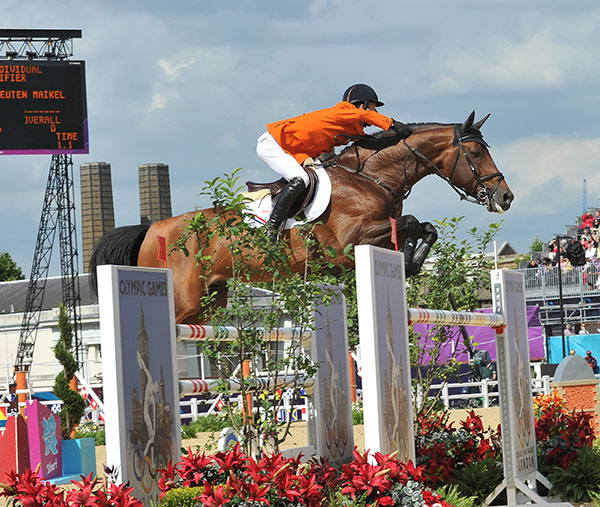
Verdi – the value continues to increase
Looking at the stallion who has remained number one in the rankings for over seven years, Heartbreaker (Nimmerdor / Silvano), his value increased from 2011/12 (175) to 2015 (182), before falling to 171 in the 2018 rankings. Considering this stallion became infertile at the end of 2012, with only very limited frozen straws still available for ICSI (invitro) fertilization, it is no surprise that this grand old man of showjumping breeding is beginning to have a diminishing influence (albeit still impressive!) on the coming generations of showjumpers. This is all making a remarkable amount of sense.
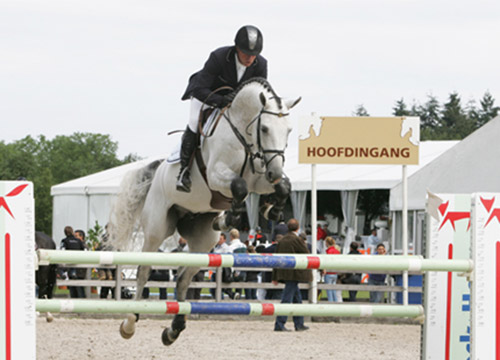
Vingino – Voltaire lives on…
A final stallion that I think deserves an honorable mention is Vingino (Voltaire / Cassini I), who over the period from 2015 to 2018 increased his breeding value from 125 to 137, while at the same time increasing his reliability from 89% to the over 90% bracket (it would be nice to see the individual reliability scores for each stallion, although I guess I can understand why they have just placed them into ‘groups’ after the utter confusion of the German numbers…)
I have been pleasantly surprised with the level of sense that has come out of these Dutch numbers, and I do think grouping them by reliability score (rather than age of offspring) provides a clearer and more logical way of looking at the different sires. I do wish they would bring back the individual reliability scores for each stallion, as one could increase from say 80% to 89% (definitely a material increase) and we would be none the wiser. But overall I really can’t complain, after having my mind completely twisted by the inconsistencies in the German numbers, the KWPN data was a welcome breath of sanity!
So ends our little collaboration – we hope you have enjoyed the result…

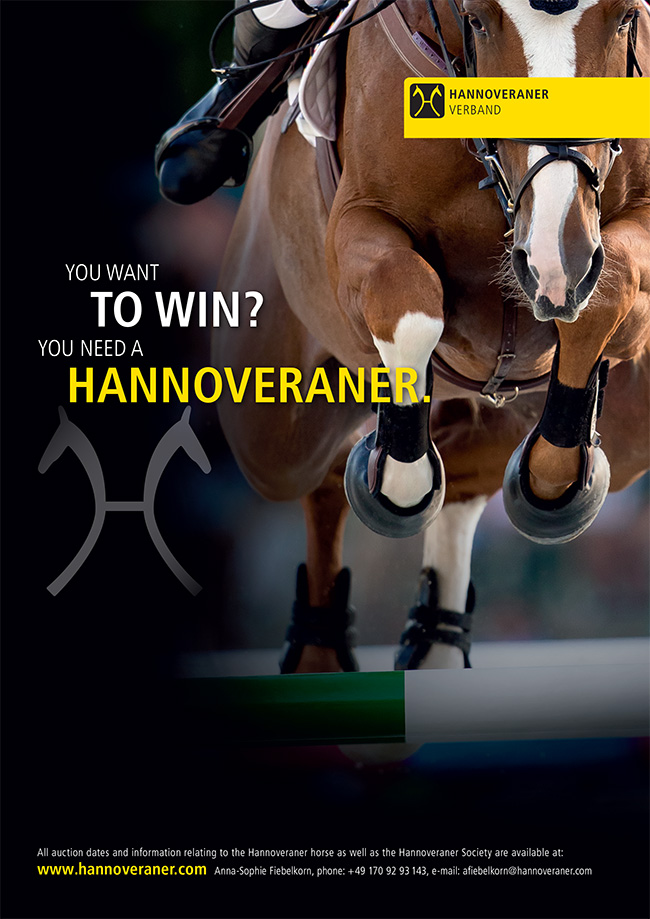
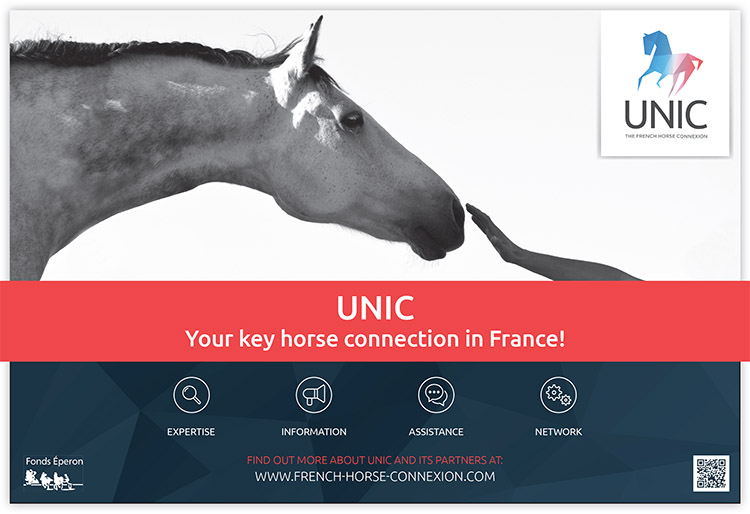
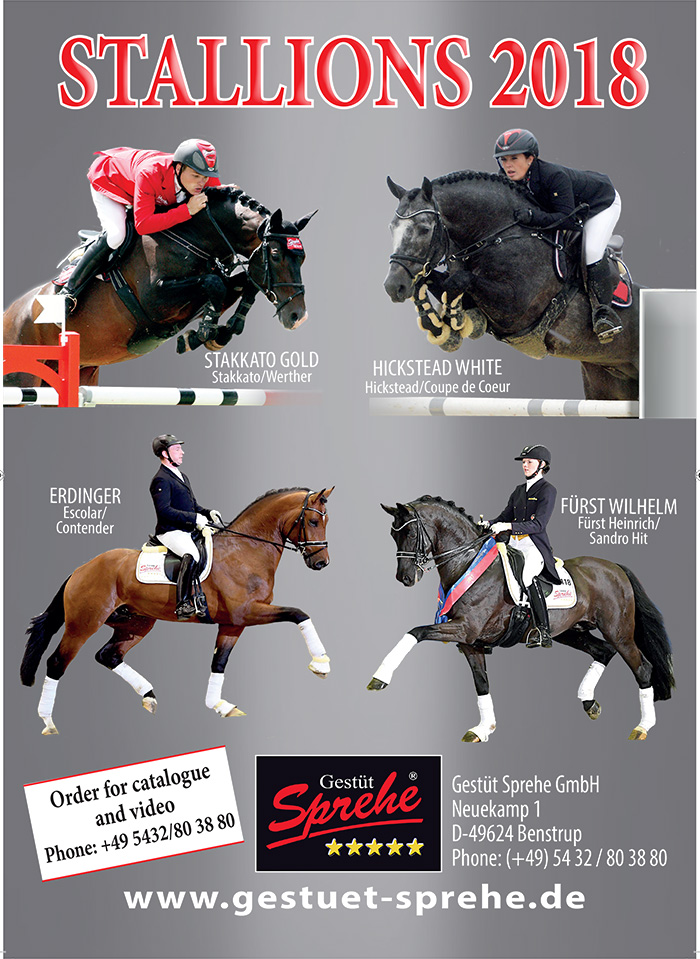
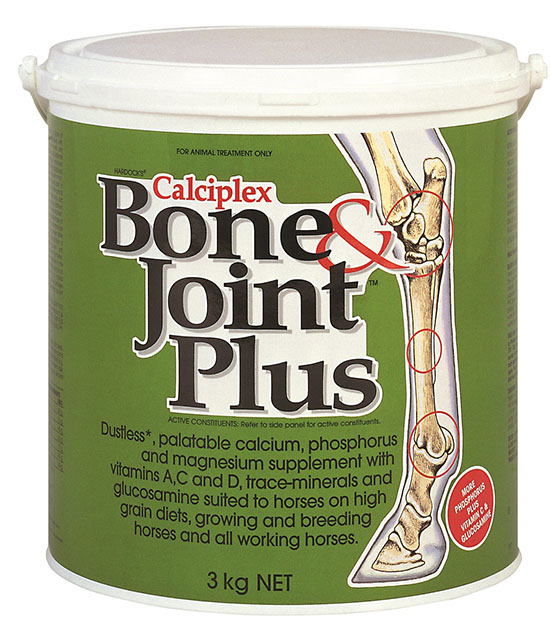
I must confess, I have followed what is happening in the dressage breeding world (thanks to Chris) for the last 20 years, and I have watched the over-importance of the young horse classes overseas with some disturbance. I’ve stopped riding for the moment, but as an amateur I look for a horse with a kind temperament (to not get too fussed over my mistakes!) and with some ability for actual dressage.
I do believe in the rule that bloodlines which have been proven at Grand Prix are the ones to look for, as Chris and others say, but ALSO I trawl various forums looking for feedback on the real life personalities of the Grand Prix bloodlines (you’ll never find me buying anything with Jazz in it after reading some of the hair-raising stories! Some of the Donnerhalls are not too great to handle either). The litmus test for me is, what are they like to live with? The Rubenstein line also seems to be either a bit crazy – or quiet as a mouse (Heath’s Regardez Moi is being spoken of as a friendly and quiet one, who also passes this onto his offspring).
I did like the ‘F’ line for a while (swayed by their ability and that Florestan has been mentioned in THM as great for amateurs) but Verdades (Florett As) gave Laura Graves a tough time for many years, so I’m not sure about that one. Verdades may just have had a spirited and sensitive dam.
“– these two are the last remnants of the once mighty Weltmeyer machine…” hmmm…… Always the dart for the Weltmeyers. Recall in another article “Weltmeyer knocked from his perch” or some such thing.
Have been covetous for a Weltmeyer since the 90’s, or at least a W line counting Werther. Reading all that has been said about Weltmeyer; Johanne Hinnermann, his test rider said of Weltmeyer; “But when I rode him at the Bundeschampionate in my opinion, he was a horse that was uncomfortable to ride, He had a 15 walk, a 15 trot and a canter for 15, you couldn’t handle that.”. Wow! Sounds like just the kind of horse I’d like to ride. Nothing worse than a horse that lacks ‘forward’, and here’s a rider complaining Weltmeyer was to forward. He never accused him of being a runaway or a bolter, just accused his gaits of being ‘to much’. Maybe Jo should have read Franz Mairinger’s: Let Horses Be Horses. Maybe Jo presumed that it was his job to ride Weltmeyer around to make Weltmeyer look good, maybe Jo only needed an attitude adjustment, maybe he just needed to sit there and do nothing but let Weltmeyer carry Jo around and make Jo look good, maybe Weltmeyer didn’t need much help to look good.. What a blessing, a thrill and a delight a Weltmeyer is to a rider who understands that basic premise. Look, look, look at all the dressage riders argue with the horse, rather than go forward with joy.
Maybe the Weltmeyers just need a certain kind of rider, and there are just very few of them. All these fancy dressage horses that raise their knees high into the air, seems so many find that so very attractive: Weltmeyer’s certainly not going to contribute to that. Hopefully my Weltmeyer line foal inherited that ‘forward’, that ’15’, and I can go for a test drive in a few years.